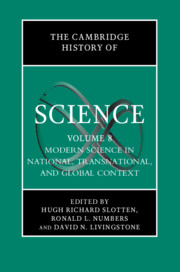Book contents
- The Cambridge History of Science
- The Cambridge History of Science
- The Cambridge History Of Science
- Copyright page
- Contents
- Notes on Contributors
- General Editors’ Preface
- 1 Introduction
- Part I Transnational, International, and Global
- Part II National and Regional
- Europe
- 11 United Kingdom
- 12 France: During the Long Nineteenth Century
- 13 France: Post-1914
- 14 Germany
- 15 Russia and the Former USSR
- 16 Low Countries
- 17 Scandinavia
- 18 Italy
- 19 Spain
- 20 Greece
- 21 Portugal
- 22 Europe: A Commentary
- Africa, the Middle East, and South Asia
- East and Southeast Asia
- United States, Canada, Australia, New Zealand, and Oceania
- Latin America
- Index
14 - Germany
from Europe
Published online by Cambridge University Press: 21 March 2020
- The Cambridge History of Science
- The Cambridge History of Science
- The Cambridge History Of Science
- Copyright page
- Contents
- Notes on Contributors
- General Editors’ Preface
- 1 Introduction
- Part I Transnational, International, and Global
- Part II National and Regional
- Europe
- 11 United Kingdom
- 12 France: During the Long Nineteenth Century
- 13 France: Post-1914
- 14 Germany
- 15 Russia and the Former USSR
- 16 Low Countries
- 17 Scandinavia
- 18 Italy
- 19 Spain
- 20 Greece
- 21 Portugal
- 22 Europe: A Commentary
- Africa, the Middle East, and South Asia
- East and Southeast Asia
- United States, Canada, Australia, New Zealand, and Oceania
- Latin America
- Index
Summary
Culturally diverse, politically fragmented, and geographically fluid, Germanic Europe has played an influential role in the development of the natural, cultural, and social sciences. Before 1648, when Germanic Europe consisted of most of the Holy Roman Empire plus East Prussia along the eastern shores of the Baltic Sea, religious strife beset the region. After the Peace of Westphalia in 1648, which removed Switzerland and the Netherlands from the Empire but kept German states and principalities and the Habsburg Monarchy, reformers viewed natural and technological knowledge as a resource for restoring political stability and social discipline. After the Holy Roman Empire crumbled in 1806 and the Congress of Vienna redrew the map of Central Europe again in 1815, Prussia, Bavaria, and the Austrian Empire (the largest German-speaking states), along with Baden and smaller states along the Rhine, nurtured a scientific culture through their bureaucracies, industries, and educational systems.
- Type
- Chapter
- Information
- The Cambridge History of Science , pp. 233 - 277Publisher: Cambridge University PressPrint publication year: 2020



